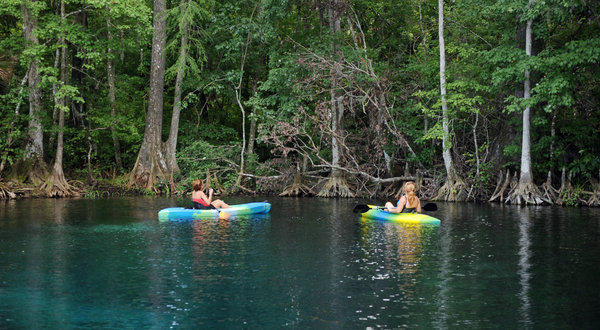Glass-bottomed boats grew famous here as did underwater photography. Even Tarzan was lured to the springs; six of the movies in the 1930s and ’40s were filmed here. Tourists arrived in droves to these springs, just outside Ocala.
The riverscape — with anhingas drying their wings in the sun, alligators lolling near the banks and native hibiscus in bloom — is beautiful. But its fragility is plain to see. Except for a few patches, the bottom of Silver Springs and Silver River are no longer visible, covered by invasive weeds coated with algae.
The springs scarcely bubble up. Its flow rate has dropped by a third. The current moves as slowly as the red-bellied turtles that sun themselves on logs, allowing toxic nitrates to choke the water.
The culprits, environmental experts say, are a recent drought in north-central Florida and decades of pumping groundwater out of the aquifer to meet the demands of Florida’s population boom, its sprinklers and its agricultural industry. To what degree the overconsumption of groundwater is to blame for the changes is being batted back and forth between environmentalists and the state’s water keepers. But, for the first time, a state with so much rain — the vast majority of it uncaptured — is beginning to seriously fret about water.
“It’s a very dramatic drop-off in flow; it raises the hair on the back of your neck if you are concerned about springs,” said Robert L. Knight, the director of the Howard T. Odum Florida Springs Institute who has spent decades studying Florida springs. “Springs are a very good canary in a coal mine because they pull water off the top of the aquifer.”
But Silver Springs is not alone in its distress. In the last 10 years, many of the famous freshwater springs and rivers in the central and northern parts of the state have seen a sharp drop-off in flows and a steady rise in algae. Nearby Rainbow Springs and River are also suffering, although not as much. The declines have accelerated rapidly in the past five years, so much so that they have galvanized Florida environmentalists to launch a broad campaign to bring attention to the problem and spur Gov. Rick Scott to act.
“Florida is a state that has historically had an abundance of water,” said Bob Graham, a former Democratic governor and United States senator who assembled the Florida Conservation Coalition last year to help safeguard the state’s water. “We have learned that we can degrade our water supplies to the point that water becomes a limitation on the quality of life in Florida. We don’t think that is necessary. But we think it is possible, if not probable, unless there are strong policies and enforcement at the state and local level for sound water practices.”

